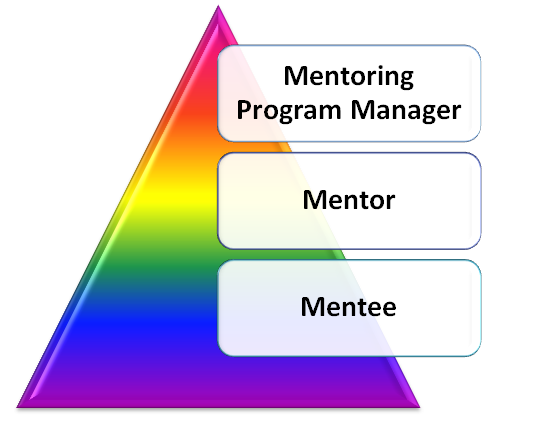M2.03. Analysing the conditions relevant to the mentoring process at the workplace
5. Resources and relevant personnel of the employing organisation
Key personnel in the mentoring process
Mentoring can improve employee satisfaction and retention, enrich new-employee initiation, make the company more appealing to recruits, and train the leaders. And the best part is that it's free. Unlike similar learning incentives like training programs or offering to pay for courses, mentoring utilizes the resources that the company already has.
The relevant personnel involved in the mentoring process are:
1. HR Manager that works also as Mentoring Program Manager: he/she oversees development, implementation and evaluation of the mentoring program; together with the mentor and the mentee he/she defines goals and objectives for the Individual Mentoring Program (IMP);
2. Mentor: he/she works with the mentee in developing and implementing an Individual Development Plan (IDP), ensures mentee work projects have start and end dates, and do not distract from the mentee’s official duties, meets routinely with the mentee to discuss and monitor progress, provides feedback and recommendations for program improvement;
3. Mentee: he/she meets routinely with mentor, actively participates in mentoring activities and goal accomplishment, and provides feedback and recommendations for program improvement.
Mentoring can improve employee satisfaction and retention, enrich new-employee initiation, make the company more appealing to recruits, and train the leaders. And the best part is that it's free. Unlike similar learning incentives like training programs or offering to pay for courses, mentoring utilizes the resources that the company already has.
The relevant personnel involved in the mentoring process are:
1. HR Manager that works also as Mentoring Program Manager: he/she oversees development, implementation and evaluation of the mentoring program; together with the mentor and the mentee he/she defines goals and objectives for the Individual Mentoring Program (IMP);
2. Mentor: he/she works with the mentee in developing and implementing an Individual Development Plan (IDP), ensures mentee work projects have start and end dates, and do not distract from the mentee’s official duties, meets routinely with the mentee to discuss and monitor progress, provides feedback and recommendations for program improvement;
3. Mentee: he/she meets routinely with mentor, actively participates in mentoring activities and goal accomplishment, and provides feedback and recommendations for program improvement.

Key personnel in the mentoring process (free elaboration)
Mentoring program documents and resources
The following documents need to be developed and provided to support a smooth process for potential mentees and mentors, to evaluate and continuously improve the mentoring program:
The following documents need to be developed and provided to support a smooth process for potential mentees and mentors, to evaluate and continuously improve the mentoring program:
- Applications (for mentees and mentors)
- Confidentiality Agreement
- Mentoring Agreement
- Mentee Action Plan
- Mentoring Log
- Evaluation Forms
Applications: Mentees and mentors must apply to participate in the mentoring program by completing an application, submitting it to their supervisor for approval before submitting it to the organization’s Mentoring Program Manager.
Confidentiality Agreement: The mentoring program must be a safe environment for mentees and mentors to freely share information about one another. To help build trust, they must be able to establish clear boundaries on how the shared information is to be treated.
Mentoring Agreement: The mentoring agreement establishes how and when the mentee and mentor will meet.
Mentee Action Plan: To determine activities to ensure mentoring goals are met, a mentee action plan is a must. The mentee will complete the plan with help from the mentor.
Mentoring Log: The mentee and mentor should record their meetings and activities to show progress achieved and assist with end-of-program feedback.
Evaluation Forms: At the mid-point of the program and at the end, you must ask the mentees and mentors to evaluate the program. Their input will help you make any necessary adjustments to ensure the program remains effective.
It could be also useful to establish a library of materials and resources to assist mentors and mentees during the program. Examples include how-to guides, job aids, and recommended reading materials and websites.
Confidentiality Agreement: The mentoring program must be a safe environment for mentees and mentors to freely share information about one another. To help build trust, they must be able to establish clear boundaries on how the shared information is to be treated.
Mentoring Agreement: The mentoring agreement establishes how and when the mentee and mentor will meet.
Mentee Action Plan: To determine activities to ensure mentoring goals are met, a mentee action plan is a must. The mentee will complete the plan with help from the mentor.
Mentoring Log: The mentee and mentor should record their meetings and activities to show progress achieved and assist with end-of-program feedback.
Evaluation Forms: At the mid-point of the program and at the end, you must ask the mentees and mentors to evaluate the program. Their input will help you make any necessary adjustments to ensure the program remains effective.
It could be also useful to establish a library of materials and resources to assist mentors and mentees during the program. Examples include how-to guides, job aids, and recommended reading materials and websites.